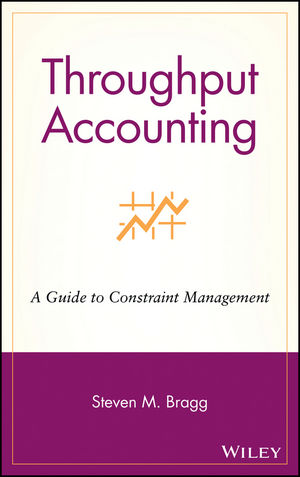Throughput Accounting: A Guide to Constraint ManagementISBN: 978-0-471-25109-5
Hardcover
192 pages
April 2007
 This is a Print-on-Demand title. It will be printed specifically to fill your order. Please allow an additional 10-15 days delivery time. The book is not returnable.
|
||||||
Preface.
1 Overview of the Theory of Constraints.
Definitions for the Operational Aspects of the Theory of Constraints.
The Operational Aspects of the Theory of Constraints.
Nature of the Constraint.
Definitions for the Financial Aspects of the Theory of Constraints.
The Financial Aspects of the Theory of Constraints.
The Opportunity Cost of Operations.
Summary.
2 Constraint Management in the Factory.
Locating the Constraint.
Management of the Constrained Resource.
Types of Policy Constraints.
The Constraint Buffer.
The Assembly Area Buffer.
Production Scheduling.
Batch Sizes.
Machine Setups—Sales Perspective.
Machine Setups—Reduction Efforts.
Summary.
3 Throughput and Traditional Cost Accounting Concepts.
The Emphasis on Cost versus Throughput.
The Emphasis on Product Cost versus System Profitability.
Variations in the Treatment of Low-Margin Products.
The Emphasis on Burdened versus Throughput Pricing.
Variations in Scrap Reporting.
Variations in Variance Analysis.
The Treatment of Direct Labor.
Inventory Valuation.
Activity-Based Costing versus Throughput Accounting.
Direct Costing versus Throughput Accounting.
Summary.
4 Throughput and Financial Analysis Scenarios.
The Basic Throughput Analysis Model.
The Low Price, High Volume Decision.
The Low Price for Export Market Decision.
The Outsourced Production Decision.
The Increased Downstream Capacity Decision.
The Increased Upstream Product Processing Decision.
The Increased Sprint Capacity Decision.
The Additional Quality Workstation Decision.
The Increased Constraint Staffing Decision.
The New Product Addition Decision.
The Product Cancellation Decision.
The Altered Product Priority Decision.
The Raw Material Constraint Decision.
The Constraint in the Marketplace Decision.
The Plant Closing Decision.
Underlying Concepts of the Throughput Analysis Model.
Summary.
5 Throughput in the Budgeting and Capital Budgeting Process.
Capital Budgeting with Throughput Accounting.
Budgeting for Revenue with Throughput Accounting.
Budgeting for New Products with Throughput Accounting.
Budgeting for Operating Expenses with Throughput Accounting.
Budgeting for Production Labor Expenses with Throughput Accounting.
Budgeting for Sales Department Expenses with Throughput Accounting.
Summary.
6 Throughput and Generally Accepted Accounting Principles.
The Nature of Generally Accepted Accounting Principles.
Differences Between Throughput and GAAP Accounting.
Income Statements for Throughput Accounting and GAAP.
Modifying the Chart of Accounts for Throughput Accounting.
Reconciling Throughput Accounting to GAAP.
Throughput Accounting and Cost-Plus Contracting.
Summary.
7 Throughput and Control Systems.
Constrained Resource Controls.
Buffer Controls.
Production Scheduling Controls.
Summary.
8 Throughput and Performance Measurement and Reporting Systems.
Ratio of Throughput to Constraint Time Consumption.
Total Throughput Dollars Quoted in the Period.
Ratio of Throughput Dollars Quoted to Throughput Firm Orders Received.
Sales Productivity.
Ratio of Throughput Booked to Shipped.
Trend Line of Sales Backlog Dollars.
Ratio of Maintenance Downtime to Operating Time on Constrained Resource.
Throughput of Post-Constraint Scrap.
Constraint Utilization.
Constraint Schedule Attainment.
Manufacturing Productivity.
Manufacturing Effectiveness.
Order Cycle Time.
Throughput Shipping Delay.
Inventory Turnover.
Return on Investment.
Throughput Contribution Report.
Buffer Management Report.
Buffer Hole Percentage Trend Report.
Misleading Measurements and Reports.
Summary.
9 Throughput and Accounting Management.
Throughput Analysis Priorities.
The Subordination Concept.
The Duration of Capacity Constraints.
The Inventory Build Concept.
The Capacity–Buffer Interrelationship.
Investment Analysis.
Price Formulation.
Transfer Pricing.
Cost Reporting.
Staffing Decisions.
The Problem with Using Throughput Accounting for Tactical Changes.
Throughput Software and Makeshift Systems.
Summary.
10 Throughput Case Studies.
Summary.
Index.



